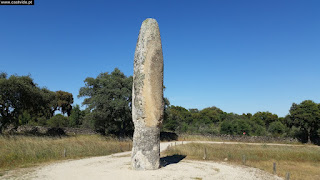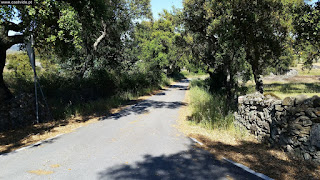

GOOGLE MAPS: OPEN MAP
It is a granite monolith, whose configuration is cylindriform-phallic, with 7m. height and a maximum diameter of 1,25m. In 1993 it was subjected to a restoration and consolidation intervention, which allowed the union of the two fragmented parts. From the various interpretations for the practice of erecting isolated stones in the prehistoric landscape, the explanation for the menhirs is the particular material testimony of ancestors of the fertility of the earth. This idea is supported by the fact that in the period corresponding to the megalithic culture the primitive hunter-gatherer communities have evolved into new agro-pastoral societies, where, consequently, the land has become of vital and prevailing importance for subsistence and economy of the people.Description: Porphyroid granite monolith with coarse grain. It has cylindriform configuration and is erect planted in the soil. The extremity is tapered - in this zone is easily perceivable a glans, in relief, somewhat eroded by erosion, which diagonally surrounds the whole monolith, thus evidencing a phallic representation. Before the work was done to restore its original appearance, the menir was divided in two parts, in which the base, in situ, emerged from the ground at 1.34 m and was slightly inclined to the west. The other portion, the larger, was in the same position as in the west. The fracture zone in these two portions was significantly altered, resulting in greater difficulty in joining the surfaces.The Menir da Meada is the most impressive megalithic monument in the region of Castelo de Vide, and the largest menir entirely carved by man throughout the Iberian Peninsula. The monolith, about 4 meters high from the ground, 7.15 m in total length and a maximum diameter of 1.25 meters, is implanted in an isolated way in the granitic plateau of the Sever River, forming part of a set of tapirs and menhirs of this lytic material, the latter implanted sequentially in the line of contact between granites and schists that delimits the megalithic spot of the Serra de São Mamede.
Although not accurate, it is safe to say that Menir da Meada was erected in the midst of the Neo-Chalcolithic period, at the same time as the great megalithic graves of the region, including the megalithic necropolis of Coureleiros. It forms a group with other menhirs of great volume, all distributed with remarkable regularity along the limit of the granitic corridor of the mountain range, delimiting the sepulchral area of the granites; its exceptional height may be precisely related to the visibility of the alignments, since the menir rises on a knoll of lesser height than the others.The menir was restored and re-erected in the 90's of the twentieth century, when it was possible to give it back its original appearance, uniting the two parts where it was fractured when it was discovered in 1965, and possibly since the Roman dominion of the region and the consequent intensification of agricultural practices. The stone presents a cylindriform configuration, with sharp phallic contours, accentuated by a resemblance similar to a glans involving the upper extremity. The smoothed surface would have been originally almost polished and the marks left by the friction instrument in the best preserved areas are still visible.Menir da Meada, of remarkable magnificence, illustrates in a unique way the importance of the region in prehistoric times, and is attested to by many other vestiges of the monumentalization of the territory by the local population. Although the real dimension of its symbolic load and its probable multifunctional features is unknown, this monolith intertwines perfectly in the geographical and cultural environment of the megalithic graves of the area of influence of the Sever River, distinguishing both individually and in the relation that establishes with the other monuments of the same typology. It constitutes a privileged testimony of the socioeconomic environment, organizational capacity, natural conditioning, knowledge, belief systems and the ritual and symbolic context of the community that generated it, presenting itself as a unique form of expression of the myth by the Neolithic man, and as a vestige of material of unquestionable value in the peninsular context.Sílvia Leite / DBC-DGPC / 2013
Trata-se de um monólito granítico, cuja configuração é
cilindriforme-fálica, com 7m. de altura e um diâmetro máximo de 1,25m. Em 1993
foi sujeito a uma intervenção de restauro e consolidação, que permitiu a união
das duas partes fragmentadas. Das diversas interpretações para a prática de se
erguerem pedras isoladas na paisagem pré-histórica assume particular aceitação
a explicação para os menires serem os actuais testemunhos materiais de
ancestrais cultos à fertilidade da terra. Esta ideia sustenta-se no facto de,
no período correspondente à cultura megalítica, as primitivas comunidades
caçadoras e recolectoras Terem evoluído para novas sociedades agro-pastoris,
onde, consequentemente, a terra passou a deter uma importância vital e
preponderante para a subsistência e economia dos povos.
Descrição: Monólito de granito porfiróide de grão grosseiro. Possuí configuração cilindriforme e está erecto fincado no solo. A extremidade apresenta-se afilada - nesta zona é facilmente perceptível uma glande, em relevo, algo desgastada pela erosão, que envolve diagonalmente todo o monólito, evidenciando, assim, uma representação fálica. Antes de serem efectuados os trabalhos com vista a restituir-lhe o seu aspecto original, o menir apresentava-se partido em duas porções, em que a base, in situ, emergia do solo 1,34m e encontrava ligeiramente inclinada para poente. A outra porção, a de maiores dimensões encontrava-se tombada, igualmente para poente. A zona de fractura nessas duas porções encontrava-se significativamente alterado, daí resultando uma maior dificuldade para a união das superfícies.
O Menir da Meada é o mais impressionante monumento
megalítico da região de Castelo de Vide, e o maior menir totalmente talhado pelo
homem em toda a Península Ibérica. O monólito, com cerca de 4 metros de altura
a partir do solo, 7,15 m de comprimento total e um diâmetro máximo de 1,25
metros, está implantado de forma isolada no patamar granítico do Rio Sever,
fazendo parte de um conjunto de antas e menires deste material lítico, estes
últimos implantados sequencialmente na linha de contacto entre granitos e
xistos que delimita a mancha megalítica da Serra de São Mamede.
Embora sem datação precisa, é seguro afirmar que o Menir da Meada foi erguido em pleno Neo-calcolítico, na mesma altura em que se construíram as grandes sepulturas megalíticas da região, incluindo a necrópole megalítica de Coureleiros. Forma um conjunto com outros menires de grande volume, todos distribuídos com assinalável regularidade ao longo do limite do corredor granítico da serra, delimitando a área sepulcral dos granitos; a sua altura excecional poderá estar justamente relacionada com a visibilidade dos alinhamentos, uma vez que o menir se eleva num outeiro de menor altura em relação aos restantes.
O menir foi restaurado e reerguido na década de 90 do século XX, quando foi possível devolver-lhe a aparência original, unindo-se as duas partes em que se encontrava fraturado aquando da sua descoberta em 1965, e possivelmente desde o domínio romano da região e a consequente intensificação das práticas agrícolas. A pedra apresenta configuração cilindriforme, de nítidos contornos fálicos, acentuados por um ressalto semelhante a uma glande envolvendo a extremidade superior. A superfície alisada teria sido, originalmente, quase polida, sendo ainda visíveis as marcas deixadas pelo instrumento de fricção nas zonas melhor conservadas.
O Menir da Meada, de notável imponência, ilustra de forma singular a importância da região na época pré-histórica, de resto atestada por muitos outros vestígios da monumentalização do território pelas populações locais. Ainda que se desconheça a real dimensão da sua carga simbólica e das suas prováveis multifuncionalidades, este monólito interliga-se perfeitamente no ambiente geográfico e cultural das sepulturas megalíticas da área de influência do Rio Sever, distinguindo-se tanto de forma individual como na relação que estabelece com os restantes monumentos da mesma tipologia. Constitui testemunho privilegiado do ambiente socioeconómico, da capacidade organizativa, das condicionantes naturais, dos conhecimentos, dos sistemas de crenças e do contexto ritual e simbólico da comunidade que o gerou, apresentando-se como uma forma ímpar de expressão do mito pelo homem do Neolítico, e como vestígio material de valor inquestionável no contexto peninsular.
Sílvia Leite / DBC-DGPC / 2013






















